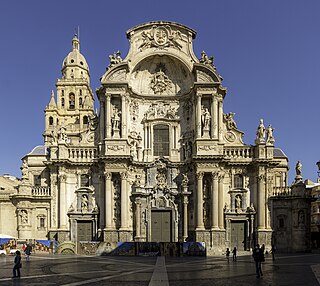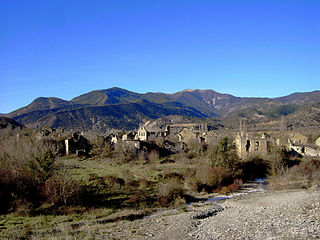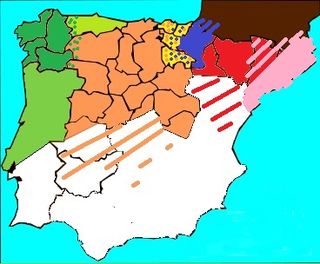
Teruel is a city in Aragon, located in eastern Spain, and is also the capital of Teruel Province. It had a population of 35,900 as of 2022, making it the least populated provincial capital in Spain. It is noted for its harsh climate, with a wide daily variation on temperatures and its renowned jamón serrano, its pottery, its surrounding archaeological sites, rock outcrops containing some of the oldest dinosaur remains of the Iberian Peninsula, and its famous events: La Vaquilla del Ángel during the weekend closest to 10 July and "Bodas de Isabel de Segura" around the third weekend of February.

Cuenca is a city and municipality of Spain located in the autonomous community of Castilla–La Mancha. It is the capital of the province of Cuenca.

Jumilla is a town and a municipality in southeastern Spain. It is located in the north east of the Region of Murcia, close to the towns of Cieza and Yecla. According to the 2018 census, the town population was 25,547.

The Cathedral Church of Saint Mary in Murcia, commonly called the Cathedral of Murcia, is a Catholic church in the city of Murcia, Spain. It is the cathedral of the Roman Catholic Diocese of Cartagena.

Spanish Baroque is a strand of Baroque architecture that evolved in Spain, its provinces, and former colonies.

La Vall de Boí is a municipality and narrow, steep-sided valley in Catalonia. It lies in the Alta Ribagorça county in the Alt Pirineu region, on the edges of the Pyrenees. In 2022, it had a population of 1,090.

The Cathedral of St. Mary of la Seu Vella is the former cathedral church of the Roman Catholic Diocese of Lleida, in Lleida, Catalonia, Spain, located on top of Lleida hill.
Santa Cilia is a municipality located in Jacetania, province of Huesca, Aragon, Spain. It is 14 km from the town of Jaca between the River Aragon and the national highway N-240.

Molina de Aragón is a municipality located in the province of Guadalajara, Castile-La Mancha, Spain. According to the 2009 census (INE), the municipality had a population of 3,671 inhabitants. It held the record (−28.2 °C) for the lowest temperature measured by a meteorological station in Spain, and now it's on the third place.

Seno is a municipality located in the Bajo Aragon area, close to Maestrazgo in province of Teruel, Aragon, Spain, at an altitude of 792 m. According to the 2018 census the municipality has a population of 39 inhabitants.

Teruel Cathedral or Catedral de Santa María de Mediavilla de Teruel is a Roman Catholic church in Teruel, Aragon, Spain. Dedicated to St. Mary, it is a notable example of Mudéjar architecture. Together with other churches in the town and in the province of Zaragoza, it has been listed as a UNESCO World Heritage Site since 1986.

Entença, Entenza or Antenza is a village in the La Franja area of Aragon. It is located at a height of 576 m above sea level in the Ribagorça comarca, Huesca Province, 10 km to the east-southeast of Benavarri, town to which it belongs administratively. Its zip code is 22580.

Solana Valley is a valley in the Pyrenees. It is located in Aragon, Spain. River Ara cuts across the valley from east to west and its average altitude is 850 m.

The Holy Cathedral of the Transfiguration of the Lord, also known as the Cathedral of Saint Mary of Huesca, is a Roman Catholic church in Huesca, in Aragon, north-eastern Spain. It is the seat of the Bishop of Huesca. Its architecture is Gothic, and its construction began in the late 13th century and was finished in the early 16th century.

Spanish Romanesque designates the Romanesque art developed in the Hispanic-Christian kingdoms of the Iberian Peninsula in the 11th and 12th centuries. Its stylistic features are essentially common to the European Romanesque although it developed particular characteristics in the different regions of the peninsula. There is no Romanesque art in the southern half of the peninsula because it remained under Muslim rule (Al-Andalus). The examples of Romanesque buildings in the central area of the peninsula are sparse and of the latest period, with virtually no presence south of the Ebro and the Tagus. Most Romanesque buildings can be found in the northern third of the peninsula. Romanesque art was introduced into the peninsula from east to west, so scholars have usually defined regional characteristics accordingly: the "eastern kingdoms" comprising the Pyrenean areas, Catalan Romanesque, Aragonese Romanesque and Navarrese Romanesque, and the "western kingdoms" comprising Castilian-Leonese Romanesque, Asturian Romanesque, Galician Romanesque and Portuguese Romanesque.

The Immaculate Conception Cathedral also called Comayagua Cathedral It is dedicated to the Virgin Mary and is located in the Central Square of the city of Comayagua in Honduras, it is one of the oldest cathedrals in Central America, it went through construction phases that date from the 16th century until it was completed inaugurated on December 8, 1711, and blessed in 1715, and many modifications since the 18th century.

The Miguelete Tower is the bell tower of the Valencia Cathedral in Valencia, Spain. It is known as El Miguelete in Castilian Spanish or Torre del Micalet in the Valencian language. Construction of the tower began in 1381 and was completed in 1429. Due to its complexity and long years of construction, it was successively directed by several master builders; the first being Andreu Juliá, from 1381. Others were José Franch (1396), Pedro Balaguer ; to Martí Llobet (1425), the last of the architects to work on the construction. Subsequently, the belfry was added (1660-1736).
























